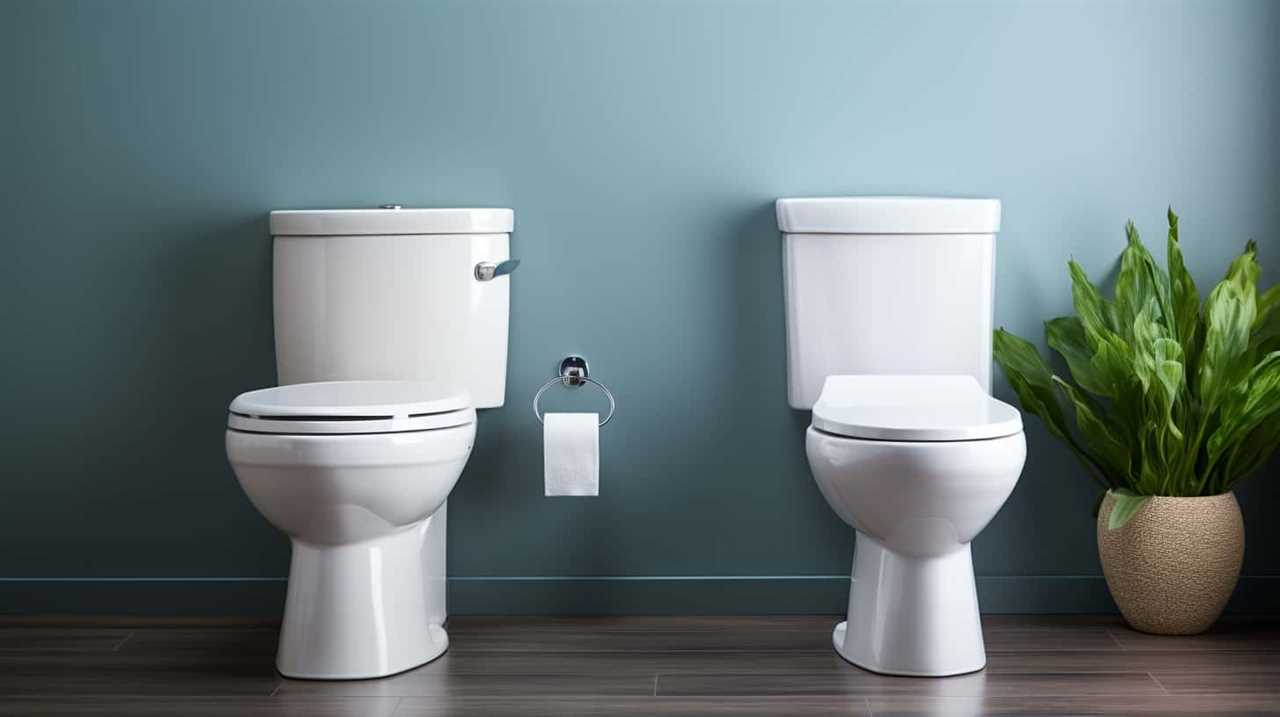We’ve all experienced it before: the unfortunate clogged toilet. But did you know that a full septic tank could be the cause? It’s a fact.
Regular maintenance of your septic tank is crucial to keep your plumbing system running smoothly.
In this article, we’ll explore the signs of a full septic tank, how it affects your toilets, and share tips on preventing those pesky clogs.
Don’t let a full septic tank ruin your day – let’s master the art of toilet maintenance together.

Key Takeaways
- A full septic tank can cause frequent backups and clogs in toilets and drains.
- Preventing toilet clogs with a full septic tank involves being mindful of what you flush, using water efficiently, scheduling regular pumping, and maintaining the plumbing system.
- Seek professional help if persistent issues or frequent backups occur, troubleshooting doesn’t resolve the problem, or signs of potential septic tank failure are present.
- Avoid common mistakes like using chemical drain cleaners and flushing non-biodegradable items.
Importance of Regular Septic Tank Maintenance
We understand the importance of regularly maintaining our septic tank to prevent any potential clogs in our toilets. By properly maintaining our septic tank, we can avoid costly repairs and ensure the longevity of our system.
One of the key benefits of using septic tank additives is that they enhance the microbial activity in the tank, breaking down solids more efficiently. This not only helps prevent clogs but also improves the overall performance of the system.
Neglecting septic tank maintenance can have severe environmental impacts. When the tank isn’t properly maintained, it can lead to leaks, groundwater contamination, and the release of harmful pathogens into the environment.
Signs of a Full Septic Tank
Regularly maintaining our septic tank is crucial to prevent any potential clogs in our toilets, and one of the signs indicating a full septic tank is a slow draining toilet. It’s important to be aware of these signs to ensure the proper functioning of our septic system. Here are some common signs of a full septic tank:

- Foul odor coming from drains or outside the house
- Gurgling sounds in the plumbing system
- Water pooling in the yard or around the septic tank area
- Slow draining sinks or showers
- Backups or overflows in toilets or drains
These signs may indicate that your septic tank is reaching its capacity and requires septic tank pumping. Common causes of a full septic tank include infrequent pumping, excessive water usage, and improper disposal of non-biodegradable items.
Regular maintenance and timely septic tank pumping can help prevent costly repairs and ensure the longevity of your septic system.
How a Full Septic Tank Affects Plumbing
One of the key ways a full septic tank affects our plumbing is by causing frequent backups and clogs in our toilets and drains. When a septic tank becomes full and reaches its capacity, it can no longer effectively process and drain the wastewater from our plumbing system. As a result, the excess wastewater can flow back into our pipes, leading to blockages and backups.
This can be particularly problematic for toilets and drains, as they’re often the first points of contact with the septic system. Additionally, a full septic tank can impact water usage as it can cause slower drainage and reduced water flow throughout the plumbing system. Common causes of septic tank overflow include infrequent pumping, excessive water usage, and system malfunctions.

Understanding how a full septic tank affects our plumbing is crucial in preventing further issues and maintaining a properly functioning system. In the following section, we’ll explore ways to prevent toilet clogs with a full septic tank.
Preventing Toilet Clogs With a Full Septic Tank
To prevent toilet clogs with a full septic tank, it’s essential to regularly maintain and pump the system. Neglecting proper maintenance can lead to costly repairs and inconveniences. Here are some toilet maintenance tips to help prevent clogs when your septic tank is near capacity:
- Be mindful of what you flush: Avoid flushing items such as wipes, sanitary products, or excessive toilet paper, as they can easily clog your system.
- Use water efficiently: Limit excessive water usage to prevent overloading the septic tank and causing backups.
- Schedule regular pumping: Regularly pumping your septic tank ensures that it operates at its optimal capacity.
- Maintain your plumbing system: Keep an eye out for leaks, drips, or slow drains as they can indicate a problem with your septic system.
- Educate household members: Teach everyone in your household about the importance of proper toilet usage and septic tank care.
By following these toilet maintenance tips and being mindful of your septic tank capacity, you can help prevent clogs and maintain a healthy plumbing system.
However, if you notice persistent issues or experience frequent backups, it may be time to seek professional help.

When to Seek Professional Help
We recommend contacting professional plumbers if you experience persistent issues or frequent backups with your septic tank.
While there are certain tasks that you can handle on your own, such as regular maintenance and minor repairs, there are times when it’s best to call a plumber.
If you have tried troubleshooting the problem but it keeps recurring, it may indicate a more serious issue that requires professional expertise.
Additionally, if you notice any signs of a potential septic tank failure, such as foul odors, slow drainage, or sewage backups in your home, it’s crucial to seek professional help immediately.

Common mistakes to avoid when dealing with a full septic tank include using chemical drain cleaners, flushing non-biodegradable items, and neglecting regular maintenance.
Conclusion
In conclusion, maintaining a septic tank is crucial to prevent toilet clogs and ensure smooth plumbing. Neglecting regular maintenance can lead to a full septic tank, which can further disrupt the flow of waste and cause blockages.
Just as a river needs a clear path to flow, our plumbing requires a well-maintained septic tank for efficient and trouble-free operation. Therefore, it’s essential to seek professional help and address any signs of a full septic tank promptly.










